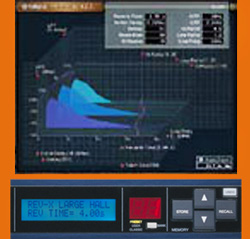Contemporary effects devices are multi-input and multi-function, with most units capable of creating reverb and delay effects simultaneously.
On vocals, the key is to tailor the effect to the tempo and character of the song. In nature, reverb decays based on the distances and surfaces in the immediate environment.
With effects processors, though, the environment is artificial so the time and density can be adjusted for each song. For instance, a two-second RT60 (the time it takes for the signal to fall 60 decibels) is useful in a mid-tempo song (96 beats per minute, or BPM) since the reverb will become non-invasive before the next phrase begins.
If the reverb time were raised to three seconds, its tail (end of the effect) would roll over into the beginning of the following phrase, making it difficult to understand the words. However, setting the reverb at one second on the same song can leave the vocals lifeless and sterile, so a compromise based on listening works best.
Reverb character is akin to musical timbre where the combination of frequency response, tonal quality, and harmonics create a unique aural signature. If, for example, the song is reflective and contemplative, the reverb should follow suit, with thick reflections and dampened high frequencies. In contrast, upbeat, energetic songs should be accompanied by bright, clear reverb settings that emulate the song’s energy and focus.
Effects Processors
As a rule, modern effect processors follow a common architecture and layout. As line-level devices, they accept input from aux sends and group outs on mixing consoles.
Typically, three knobs populate the left section of a processor’s faceplate. One is dedicated to input level, one to output level and one to the ratio between the unaffected (dry) signal and the affected (wet) signal.
The wet/dry control should be in the fully wet position in a sound system environment. Only when a musician connects the unit directly to an instrument amplifier should the control be moved from the wet position in order to blend the dry signal into the processor output path.
Input and output are designed to work best at a unity gain setting where the output level matches that of the input. Digital devices require a strong signal to achieve the best sound quality. Input meters should illuminate just below the clipping indicator during a loud passage.
If the input is allowed to increase beyond the processor’s range, a distinctly unpleasant sound will be generated and returned through the sound system. Conversely, too low an input level will hamper the clarity of the output, often evidenced as hiss and graininess.
If a spare compressor channel is available, it can be looped into the signal path just prior to the effect’s input. The compressor can be set to reduce peaks enough to keep them within the effect processor’s dynamic range (the difference between soft and loud signals).





